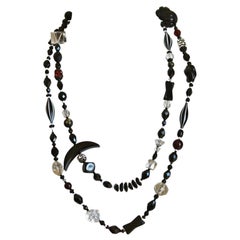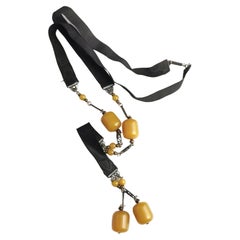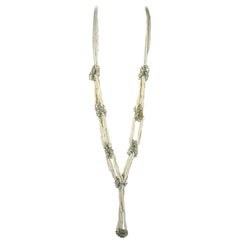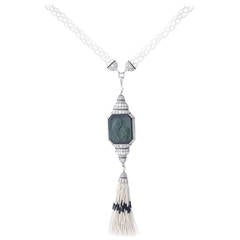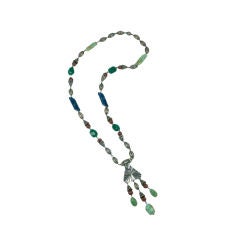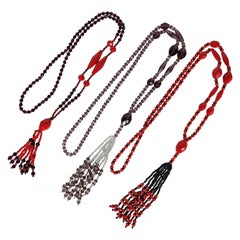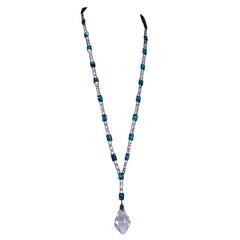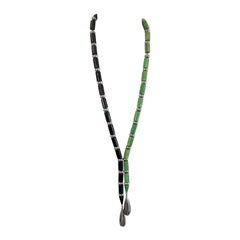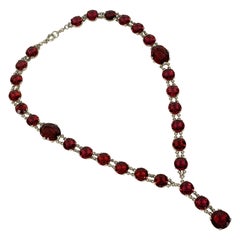Art Deco Sautoir
20th Century French Beaded Necklaces
Crystal
Early 20th Century British Art Deco Drop Necklaces
Steel
Vintage 1920s French Art Deco Beaded Necklaces
Vintage 1920s Art Deco Drop Necklaces
Natural Pearl, Onyx, Tourmaline, White Diamond, Platinum
Early 20th Century French Art Deco More Necklaces
Vintage 1920s French Art Deco Beaded Necklaces
Early 20th Century French Art Deco Link Necklaces
Gilt Metal
Vintage 1920s German Art Deco Drop Necklaces
Silver Plate
Vintage 1920s French Art Deco Link Necklaces
Silver Plate, Brass, Gilt Metal
Vintage 1920s French Art Deco Pendant Necklaces
Gilt Metal
Vintage 1920s Unknown Art Deco Beaded Necklaces
Base Metal
Vintage 1930s Unknown Art Deco Drop Necklaces
Citrine, Silver Plate, Sterling Silver
Vintage 1920s Art Deco Choker Necklaces
Vintage 1920s Unknown Art Deco Beaded Necklaces
Vintage 1920s Art Deco Beaded Necklaces
Vintage 1930s Unknown Art Deco Beaded Necklaces
Vintage 1920s French Art Deco Link Necklaces
Gilt Metal
Vintage 1930s French Art Deco Beaded Necklaces
Gilt Metal
2010s Italian Art Deco Beaded Necklaces
White Diamond, Sapphire, Blue Sapphire, 18k Gold, White Gold, Gold
Early 20th Century British Art Deco Drop Necklaces
Vintage 1930s Unknown Art Deco Rope Necklaces
Natural Pearl, Platinum
Vintage 1920s American Art Deco Beaded Necklaces
Diamond, Jade, Platinum
Vintage 1920s American Art Deco Pendant Necklaces
Coral, Diamond, Jade, Onyx, Platinum
2010s Italian Art Deco Chain Necklaces
Emerald, Gold, 18k Gold, Yellow Gold
2010s Italian Art Deco Chain Necklaces
Emerald, Gold, 18k Gold, Yellow Gold
2010s Italian Art Deco Link Necklaces
Garnet, Gold, 18k Gold, Yellow Gold
21st Century and Contemporary French Pendant Necklaces
Vintage 1920s American Art Deco Beaded Necklaces
Onyx, Pearl, Gold, 14k Gold, White Gold
Vintage 1920s American Art Deco Link Necklaces
Onyx, Pearl, Natural Pearl, Platinum
20th Century Art Deco Beaded Necklaces
Coral, Diamond, Emerald, Onyx, Platinum
2010s Italian Art Deco Link Necklaces
White Diamond, Brown Diamond, 18k Gold, Yellow Gold, Gold
21st Century and Contemporary American Art Deco Beaded Necklaces
Coral, Onyx, Pearl, Rhodium, Sterling Silver
2010s Italian Artisan Beaded Necklaces
White Diamond, Sapphire, Gold, 18k Gold, White Gold
Vintage 1930s Beaded Necklaces
21st Century and Contemporary American Artisan Beaded Necklaces
Onyx, Pearl, Gold, 14k Gold, Yellow Gold
2010s Italian Artisan Beaded Necklaces
Brown Diamond, Yellow Gold, Gold, 18k Gold
Vintage 1920s Unknown Art Deco Link Necklaces
Silver Plate
Vintage 1930s French Art Deco Pendant Necklaces
Pearl, Gold
Vintage 1920s American Art Deco Desk Accessories
Diamond, White Diamond, Gold, 18k Gold, Yellow Gold, Platinum, Enamel
Early 20th Century Art Deco Drop Necklaces
Diamond, Moonstone, Pearl, 18k Gold
2010s American Art Deco Beaded Necklaces
Coral, Jade, Onyx, Rock Crystal
Vintage 1950s French Art Deco Beaded Necklaces
Silver Plate, Bronze, Enamel
Vintage 1920s American Art Deco Link Necklaces
Mixed Metal
Vintage 1950s Art Deco Rope Necklaces
Diamond, Moonstone, Onyx, Rock Crystal, 18k Gold, White Gold, Platinum
Vintage 1920s American Art Deco Beaded Necklaces
20th Century French Art Deco Drop Necklaces
Hematite, Marcasite, Silver Plate, Cut Steel, Gilt Metal
Vintage 1930s French Art Deco Beaded Necklaces
Gold-filled, Yellow Gold, Silver, Brass, Copper
2010s American Art Deco Rope Necklaces
Emerald, Black Pearl, Rock Crystal, 18k Gold
Vintage 1950s French Art Deco Multi-Strand Necklaces
Crystal, Mixed Metal
Vintage 1920s French Art Deco Beaded Necklaces
Base Metal
Vintage 1920s American Art Deco Pendant Necklaces
Crystal, Pearl, Freshwater Pearl, Natural Pearl, Coral, Silver
Early 20th Century Edwardian Drop Earrings
Pearl, Diamond, White Diamond, Onyx, 18k Gold
2010s Italian Art Deco Beaded Necklaces
White Diamond, Sapphire, Gold, 18k Gold, White Gold
2010s Italian Art Deco Beaded Necklaces
White Diamond, Sapphire, Gold, 18k Gold, White Gold
21st Century and Contemporary Italian Artist Chain Necklaces
White Diamond, Crystal, Black Pearl, Cultured Pearl, Diamond, South Sea ...
2010s Italian Art Deco Chain Necklaces
Sapphire, Gold, 18k Gold, White Gold, Yellow Gold
Vintage 1920s German Art Deco Beaded Necklaces
Crystal, Base Metal
Vintage 1930s German Art Deco Drop Necklaces
Base Metal
2010s American Art Deco Beaded Necklaces
Coral, Diamond, Morganite, White Gold
Vintage 1970s American Art Deco Drop Necklaces
Diamond, White Diamond, Jade, Onyx, Gold, 18k Gold, Yellow Gold
- 1
Art Deco Sautoir For Sale on 1stDibs
How Much is a Art Deco Sautoir?
A Close Look at art-deco Jewelry
Fascination with the Jazz Age is endless, and even today jewelry designers continue to be inspired by authentic Art Deco jewelry and watches.
The Art Deco period, encompassing the 1920s and ’30s, ushered in a very distinct look in the design of jewelry. There were many influences on the jewelry of the era that actually began to take shape prior to the 1920s. In 1909, Serge Diaghilev brought the Ballet Russes to Paris, and women went wild for the company’s exotic and vibrant costumes It’s no wonder, then, that jade, lapis lazuli, coral, turquoise and other bright gemstones became all the rage. There already existed a fascination with the East, particularly China and Japan, and motifs consisting of fans and masks started to show up in Art Deco jewelry.
However, the event that had the greatest influence on Deco was the excavation of the tomb of King Tut in 1922. When the world saw what was hidden in Tut’s burial chamber, it sent just about everyone into a frenzy. Pierre Cartier wrote in 1923 that “the discovery of the tomb will bring some sweeping changes in fashion jewelry.” And he couldn’t have been more right. “Egyptomania” left an indelible mark on all of the major jewelry houses, from Cartier to Van Cleef & Arpels, Boucheron and Georges Fouquet. (Cartier created some of the most iconic jewelry designs that defined this era.)
While a lot of Art Deco jewelry was black and white — the black coming from the use of onyx or black enamel and the white from rock crystal and diamonds — there is plenty of color in jewelry of the era. A perfect accent to diamonds in platinum settings were blue sapphires, emeralds and rubies, and these stones were also used in combination with each other.
Many designers employed coral, jade and lapis lazuli, too. In fact, some of the most important avant-garde jewelers of the period, like Jean Després and Jean Fouquet (son of Georges), would combine white gold with ebony and malachite for a jolt of color.
A lot of the jewelry produced during this time nodded to current fashion trends, and women often accessorized their accessories. The cloche hat was often accented with geometric diamond brooches or double-clip brooches. Backless evening dresses looked fabulous with sautoir necklaces, and long pearl necklaces that ended with tassels, popular during the Edwardian period, were favored by women everywhere, including Coco Chanel.
Find unique Art Deco necklaces, earrings, bracelets and other jewelry on 1stDibs.
Finding the Right necklaces for You
We are fortunate to know much of the world’s long and dazzling history of necklaces, as this type of jewelry was so treasured that it was frequently buried with its owners.
Lapis lazuli beads adorned necklaces unearthed from the royal graves at the ancient Iraqi civilization of Sumer, while the excavation of King Tut’s burial chamber revealed a sense of style that led to a frenzy of Art Deco designs, with artisans of the 1920s seeking to emulate the elegant work crafted by Ancient Egypt’s goldsmiths and jewelry makers.
In ancient times, pendant necklaces worn by royalty and nobles conferred wealth and prestige. Today, wearing jewelry is about personal expression: Luxury diamond necklaces exude confidence and can symbolize the celebratory nature of a deep romantic relationship, while paper-clip chain-link necklaces designed by the likes of goldsmith Faye Kim are firmly planted in the past as well as the present. Kim works exclusively with eco-friendly gold, and these fashionable, fun accessories owe to the design of 19th-century watch fobs.
For some, necklaces are thought of as being a solely feminine piece, but this widely loved accessory has been gender-neutral for eons. In fact, just as women rarely took to wearing a single necklace during the Renaissance, men of the era layered chains and valuable pendants atop their bejeweled clothing. In modern times, the free-spirited hippie and counterculture movements of the 1960s saw costume-jewelry designers celebrating self-expression through colorful multistrand necklaces and no shortage of beads, which were worn by anyone and everyone.
Even after all of these years, the necklace remains an irrefutable staple of any complete outfit. Although new trends in jewelry are constantly emerging, the glamour and beauty of the past continue to inform modern styles and designs. In a way, the cyclical history of the necklace differs little from its familiar looped form: The celebrated French jewelry house Van Cleef & Arpels found much inspiration in King Tut, and, now, their Alhambra collection is a go-to for modern royals. Vintage necklaces designed by David Webb — whose work landed him on the cover of Vogue in 1950, two years after opening his Manhattan shop — were likely inspired by the ornamental styles of ancient Greece, Mesopotamia and Egypt.
On 1stDibs, browse top designers like Cartier, Tiffany & Co. and Bulgari, or shop by your favorite style, from eye-catching choker necklaces to understated links to pearl necklaces and more.
- What is art deco jewelry?1 Answer1stDibs ExpertFebruary 22, 2021Art Deco jewelry was popular during the design movement of the 1920s and 30s. Art Deco jewelry is typically characterized by geometric patterns and gemstones of contrasting colors.
- What is an art deco watch?1 Answer1stDibs ExpertApril 5, 2022An art deco watch is defined by its geometric case, which is either circular or rectangular. The watch style was highly popular between 1920 and 1950, and is still sought after today. You’ll find a collection of art deco watches from some of the world’s top sellers on 1stDibs
- How do I identify Art Deco?1 Answer1stDibs ExpertApril 5, 2022To identify Art Deco, look for the characteristics of the period. Furniture produced at the time is generally lacquered metal with a mirror-like glossy finish. Wooden items should be an exotic wood. Most items feature symmetrical designs, and geometric forms were popular motifs during the period. In addition, Art Deco often shows the influence of Hellenistic, Egyptian and Asian designs. Shop a variety of Art Deco furniture and decorative objects on 1stDibs.
- What is an Art Deco lamp?1 Answer1stDibs ExpertApril 5, 2022An Art Deco lamp is any lamp that’s made in the styles of the Art Deco movement, which was dominant in the 1920s and 1930s. On 1stDibs, you’ll find a collection of Art Deco lamps from some of the world’s top sellers.
- What is art deco ring?1 Answer1stDibs ExpertAugust 17, 2021Art Deco rings were made during the early 20th century. Named for a design movement that originated at a large decorative arts exhibition held in Paris in 1925, Art Deco rings are generally quite geometric, symmetrical and incorporate a variety of gemstones — especially sapphires and emeralds. Find a wide variety of Art Deco rings for sale on 1stDibs.
- What was Art Deco influenced by?1 Answer1stDibs ExpertMay 3, 2024Art Deco was influenced by a number of things. The discovery of ancient tombs around the turn of the century led to a renewed interest in Egyptian furniture and architecture that inspired Art Deco designers. Art Deco was also informed by Cubism, Futurism, Louis XVI style, De Stijl, modernism and the Vienna Secession. Shop a large collection of Art Deco furniture, decorative objects and jewelry on 1stDibs.
- When did Art Deco originate?1 Answer1stDibs ExpertFebruary 1, 2024The Art Deco period originated in France. Its name comes from the title of a large decorative arts exhibition held in Paris in 1925, credited with introducing the style to the world. It was informed by ancient Egypt, Cubism, Futurism, Louis XVI, De Stijl, modernism and the Vienna Secession and went on to influence the Streamline Moderne and mid-century modern movements. Shop a wide range of Art Deco furniture, decorative objects and jewelry on 1stDibs.
- What is the history of Art Deco?1 Answer1stDibs ExpertMarch 25, 2024The history of Art Deco begins in the early 20th century.
Art Deco emerged as a global design style around the start of World War I, during the last years of Art Nouveau's popularity. The style conjures visions of the Roaring Twenties, Machine Age metropolises, vast ocean liners, sleek typography and Prohibition-era hedonism. Its hallmarks include the use of geometric designs influenced by Cubism. Major discoveries of Egyptian tombs during the era also influenced the movement.
The term Art Deco derives from the name of a large decorative arts exhibition, the Exposition Internationale des Arts Décoratifs et Industriels Modernes, held in Paris in 1925. After World War II, tastes shifted toward more functional, less ornate modernism, but today, the Art Deco style is still favored for its luxurious sophistication. On 1stDibs, shop a large selection of vintage Art Deco furniture. - What defines Art Deco?1 Answer1stDibs ExpertApril 5, 2024A few things define Art Deco. Date is one factor, as the style emerged in the 1920s and remained popular during the 1930s. Art Deco design usually includes bold geometric lines and forms or intricate repeating floral motifs. Designers working in this style tended to use expensive materials, such as shagreen or marble, as well as exotic woods like mahogany, ebony and zebra wood. Furniture often featured metal accents, mirrored finishes and embellishments made from exotic animal hides and inlays of mother-of-pearl or ivory. Shop a wide range of Art Deco furniture on 1stDibs.
- 1stDibs ExpertAugust 15, 2019
The main difference between Art Nouveau and Art Deco is that the former is detailed and ornate, and the latter is sharp and geometrical. When the movement started at the end of the 19th century, Art Nouveau was heavily influenced by nature and the curved lines of flowers. Art Deco, which became popular in the beginning of the 20th century, was inspired by the geometric abstraction of cubism.
- Are Art Deco rings timeless?1 Answer1stDibs ExpertOctober 30, 2023Yes, Art Deco rings are timeless by many people's standards. Inspired by architecture, Art Deco jewelry pieces show off intricate geometric designs that have remained stylish decade after decade. Plus, the most commonly used materials during the Art Deco period, like platinum and 14-karat yellow gold, are classics. Shop a variety of Art Deco rings on 1stDibs.
- What era was Art Deco rings?1 Answer1stDibs ExpertJune 30, 2023Art Deco rings are from the era of the 1920s and 1930s. While Art Deco began to emerge a bit earlier than that, the style truly gained momentum after the end of World War I. Rings from the time period often feature geometric motifs, bold colors and designs that were influenced by Cubism, Futurism and other movements in visual art. Diamonds were exceptionally popular, while accent gems such as sapphires, emeralds and rubies brought vivid color to engagement rings and added sophistication and glamour. On 1stDibs, shop a variety of Art Deco rings.
- What is Art Deco’s time period?1 Answer1stDibs ExpertSeptember 25, 2019
The Art Deco era is 1925 to 1940.
- What does Art Deco ring mean?1 Answer1stDibs ExpertFebruary 17, 2023The term Art Deco ring means a ring produced in the Art Deco style. Most Art Deco jewelry dates back to the 1920s and 30s and features defined lines and geometric motifs. While a lot of Art Deco rings were black and white — the black coming from the use of onyx or black enamel and the white from rock crystal and diamonds — there is plenty of color in jewelry of the era. A perfect accent to diamonds in platinum settings were blue sapphires, emeralds and rubies, and these stones were also used in combination with each other. On 1stDibs, find a variety of Art Deco rings.
- 1stDibs ExpertSeptember 25, 2019
Art Deco is characterized by geometric shapes, bold colors, visual drama and metallic finishes.
- 1stDibs ExpertApril 5, 2022There are a few tell-tale signs you can look for to determine if a ring is from the Art Deco period. The first big sign is if it has a geometric element to it, as this was a big element of all Art Deco designs. Colored stones were also very popular in the period and it’s not uncommon to see sapphires or rubies taking center stage, rather than a diamond. During the Art Deco period, yellow gold was not very common, instead, jewelers crafted pieces of white gold or platinum. Shop a collection of authentic Art Deco jewelry from some of the world’s top boutiques on 1stDibs.
- 1stDibs ExpertSeptember 25, 2019
Among the key Art Deco designers were Tamara de Lempicka, Erté, René Lalique, Le Corbusier, Jean Dunand, Léon Bakst, Émile-Jacques Ruhlmann, Sonia Delaunay, Georges Lepape and Jean Després.
- 1stDibs ExpertMarch 31, 2023The simplest way to make an Art Deco bedroom is to purchase authentic furniture and decorative accents from the 1920s and ‘30s. Top designers from the period include Émile-Jacques Ruhlmann, Eileen Gray, Maurice Dufrêne and Jules Leleu. Pair authentic Art Deco pieces with a bedding set in a colorful, intricate floral print, or dress up the walls with wallpaper in a geometric motif with hints of gold. The iconic Art Deco movement made an indelible mark on all fields of design throughout the 1920s and ’30s, celebrating society’s growing industrialization with refined elegance and stunning craftsmanship. Find a selection of Art Deco furniture and decor from some of the world's top sellers on 1stDibs.
- 1stDibs ExpertFebruary 1, 2024The years between 1920 and 1939 are generally considered to be the age of Art Deco. However, the name of the movement didn't arrive until 1925, when the Exposition Internationale des Arts Décoratifs et Industriels Modernes in Paris, France, introduced Art Deco design to the world. After the 1930s, Art Deco continued to have an impact, influencing the Streamline Moderne and mid-century modern styles. On 1stDibs, explore a large selection of Art Deco jewelry, furniture and decorative objects.
- 1stDibs ExpertFebruary 27, 2024In its time, Art Deco went out of style due to shifts in trends. After World War II, designers became more interested in modernism and creating pieces with an emphasis on function and simplicity, a move away from the embellishment and adornment that characterized the Art Deco style. It's important to note that Art Deco never fully disappeared. In fact, many present-day collectors have a passion for pieces produced during the 1920s and ’30s. Shop a large selection of Art Deco furniture on 1stDibs.
